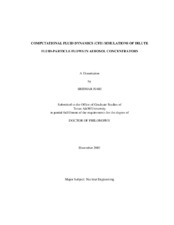| dc.description.abstract | In this study, commercially available Computational Fluid Dynamics (CFD) software, CFX-4.4 has been used for the simulations of aerosol transport through various aerosol-sampling devices. Aerosol transport was modeled as a classical dilute and dispersed two-phase flow problem. Eulerian-Lagrangian framework was adopted wherein the fluid was treated as the continuous phase and aerosol as the dispersed phase, with a one-way coupling between the phases. Initially, performance of the particle transport algorithm implemented in the code was validated against available experimental and numerical data in the literature. Code predictions were found to be in good agreement against experimental data and previous numerical predictions. As a next step, the code was used as a tool to optimize the performance of a virtual impactor prototype. Suggestions on critical geometrical details available in the literature, for a virtual impactor, were numerically investigated on the prototype and the optimum set of parameters was determined. Performance curves were generated for the optimized design at various operating conditions. A computational model of the Linear Slot Virtual Impactor (LSVI) fabricated based on the optimization study, was constructed using the worst-case values of the measured geometrical parameters, with offsets in the horizontal and vertical planes. Simulations were performed on this model for the LSVI operating conditions. Behavior of various sized particles inside the impactor was illustrated with the corresponding particle tracks. Fair agreement was obtained between code predictions and experimental results. Important information on the virtual impactor performance, not known earlier, or, not reported in the literature in the past, obtained from this study, is presented. In the final part of this study, simulations on aerosol deposition in turbulent pipe flow were performed. Code predictions were found to be completely uncorrelated to experimental data. The discrepancy was traced to the performance of the code's turbulent dispersion model. A detailed literature survey revealed the inherent technical deficiencies in the model, even for particle dispersion. Based on the results of this study, it was determined that while the code can be used for simulating aerosol transport under laminar flow conditions, it is not capable of simulating aerosol transport under turbulent flow conditions. | en |


